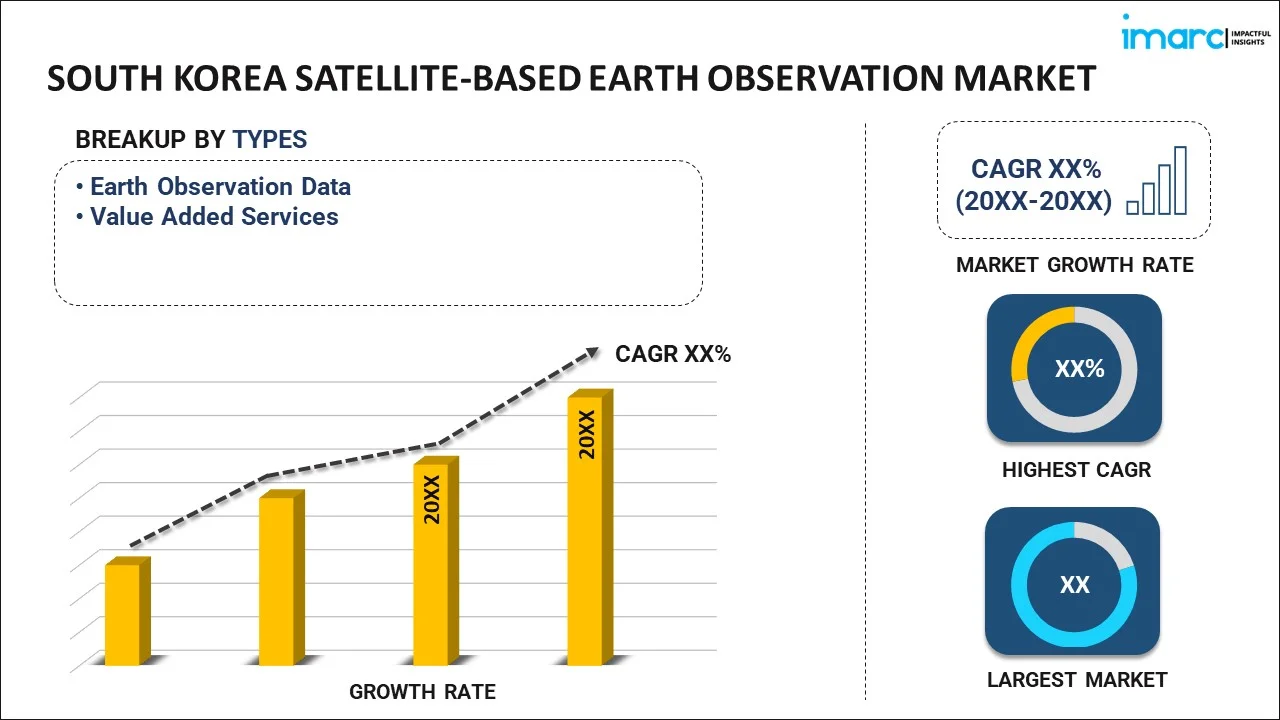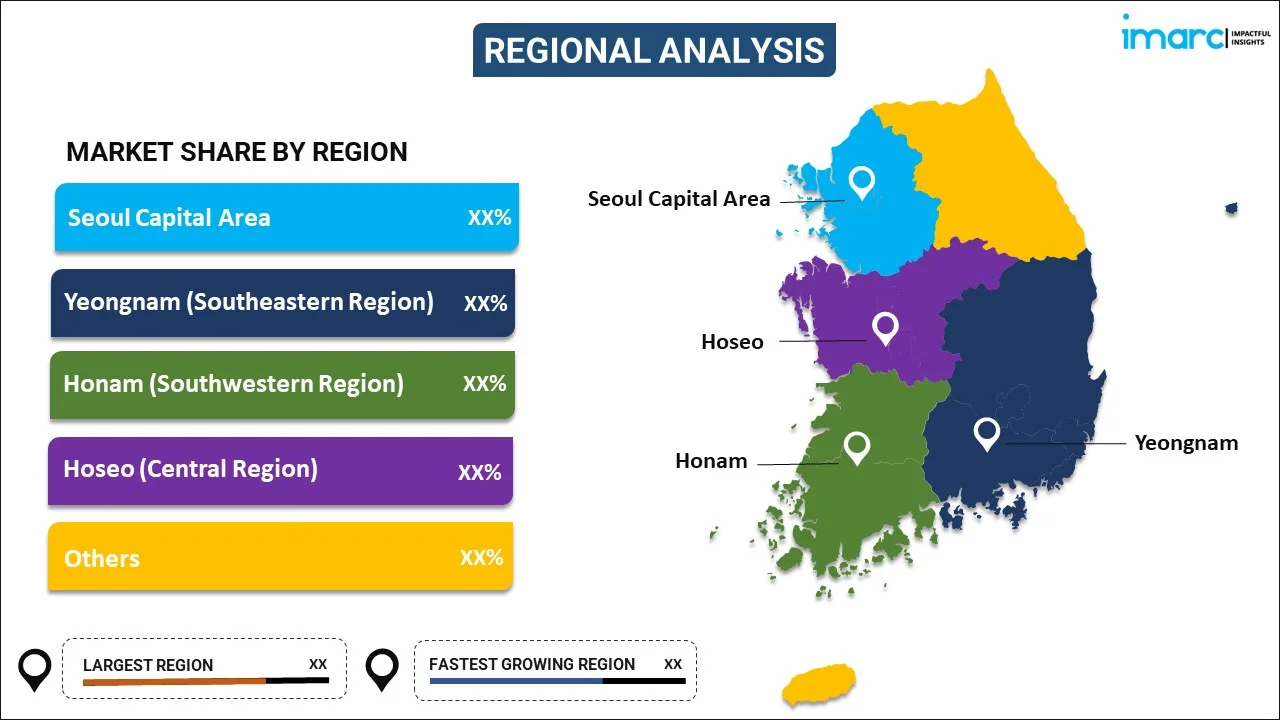
South Korea Satellite-Based Earth Observation Market Report by Type (Earth Observation Data, Value Added Services), Satellite Orbit (Low Earth Orbit, Medium Earth Orbit, Geostationary Orbit), End User (Urban Development and Cultural Heritage, Agriculture, Climate Services, Energy and Raw Materials, Infrastructure, and Others), and Region 2025-2033
Market Overview:
The South Korea satellite-based earth observation market size reached USD 70.0 Million in 2024. Looking forward, IMARC Group expects the market to reach USD 110.0 Million by 2033, exhibiting a growth rate (CAGR) of 4.5% during 2025-2033. The burgeoning technological advancements in aerospace ad satellite communication, the implementation of various government initiatives, rising need for accurate and real-time data, and the integration of artificial intelligence (AI) and machine learning (ML) represent some of the key factors driving the market.
|
Report Attribute
|
Key Statistics
|
|---|---|
|
Base Year
|
2024
|
|
Forecast Years
|
2025-2033
|
|
Historical Years
|
2019-2024
|
| Market Size in 2024 | USD 70.0 Million |
| Market Forecast in 2033 | USD 110.0 Million |
| Market Growth Rate 2025-2033 | 4.5% |
Satellite-based earth observation refers to the utilization of artificial satellites to collect and analyze data about the Earth’s atmosphere, land, and oceans. It involves various types of satellites, such as geostationary, polar-orbiting, and sun-synchronous. Satellite-based earth observation is comprised of different components, including high-resolution imaging instruments, radar systems, and thermal detectors. They are constructed using lightweight composites, aluminum alloys, and specialized thermal protection systems to withstand the extreme conditions of space. Satellite-based earth observation finds application in weather forecasting, environmental monitoring, natural disaster management, agricultural planning, military surveillance, and land-use mapping. It offers real-time data collection, global coverage, high temporal resolution, and the ability to capture data in remote or inaccessible locations. Moreover, satellite-based earth observation provides cost-effectiveness over long-term operations, consistent data quality, adaptability, and multi-temporal analysis.
South Korea Satellite-Based Earth Observation Market Trends:
The burgeoning technological advancement in aerospace and satellite communication in the country is one of the major factors propelling the market growth. Besides this, the strategic geographic location of South Korea, making it a crucial hub for Earth observation, particularly for monitoring climate patterns and natural disasters in the Asia-Pacific region, is providing a thrust to the market growth. Additionally, the implementation of various government initiatives that aim to place South Korea as a global aerospace powerhouse, stimulating investment in satellite-based Earth observation technologies, is boosting the market growth. Furthermore, the rising need for accurate and real-time data in sectors like agriculture, urban planning, and natural resource management is fueling the market growth. In addition to this, the widespread utilization of satellite-based earth observation in various applications like flood forecasting, forest fire detection, and the monitoring of illegal fishing activities is providing a considerable boost to the market growth. Along with this, the increasing integration of artificial intelligence (AI) and machine learning (ML) algorithms to analyze the vast amounts of data collected, making the information more actionable and enhancing decision-making processes is positively impacting the market growth. Besides this, the rising involvement of the private sector due to liberalized policies and financial support for startups specializing in satellite-based services is supporting the market growth. In line with this, the increasing collaboration between the government, academic institutions, and private enterprises, leading to the development of cutting-edge technologies, is amplifying the market growth. Furthermore, the growing adoption of miniaturized satellites, or CubeSats, for specific observation missions, offering cost-effectiveness and quicker deployment, is acting as a growth-inducing factor. Apart from this, the advent of international partnerships and collaboration agreements for knowledge sharing, technology transfer, and cooperative missions is also fostering the market growth.
South Korea Satellite-based Earth Observation Market Segmentation:
IMARC Group provides an analysis of the key trends in each segment of the market, along with forecasts at the country level for 2025-2033. Our report has categorized the market based on type, satellite orbit, and end user.
Type Insights:

- Earth Observation Data
- Value Added Services
The report has provided a detailed breakup and analysis of the market based on the type. This includes earth observation data and value added services.
Satellite Orbit Insights:
- Low Earth Orbit
- Medium Earth Orbit
- Geostationary Orbit
A detailed breakup and analysis of the market based on the satellite orbit have also been provided in the report. This includes low earth orbit, medium earth orbit, and geostationary orbit.
End User Insights:
- Urban Development and Cultural Heritage
- Agriculture
- Climate Services
- Energy and Raw Materials
- Infrastructure
- Others
The report has provided a detailed breakup and analysis of the market based on the end user. This includes urban development and cultural heritage, agriculture, climate services, energy and raw materials, infrastructure, and others.
Regional Insights:

- Seoul Capital Area
- Yeongnam (Southeastern Region)
- Honam (Southwestern Region)
- Hoseo (Central Region)
- Others
The report has also provided a comprehensive analysis of all the major regional markets, which include Seoul Capital Area, Yeongnam (Southeastern Region), Honam (Southwestern Region), Hoseo (Central Region), and Others.
Competitive Landscape:
The market research report has also provided a comprehensive analysis of the competitive landscape in the market. Competitive analysis such as market structure, key player positioning, top winning strategies, competitive dashboard, and company evaluation quadrant has been covered in the report. Also, detailed profiles of all major companies have been provided.
South Korea Satellite-based Earth Observation Market Report Coverage:
| Report Features | Details |
|---|---|
| Base Year of the Analysis | 2024 |
| Historical Period | 2019-2024 |
| Forecast Period | 2025-2033 |
| Units | Million USD |
| Scope of the Report | Exploration of Historical and Forecast Trends, Industry Catalysts and Challenges, Segment-Wise Historical and Predictive Market Assessment:
|
| Types Covered | Earth Observation Data, Value Added Services |
| Satellite Orbits Covered | Low Earth Orbit, Medium Earth Orbit, Geostationary Orbit |
| End Users Covered | Urban Development and Cultural Heritage, Agriculture, Climate Services, Energy and Raw Materials, Infrastructure, Others |
| Regions Covered | Seoul Capital Area, Yeongnam (Southeastern Region), Honam (Southwestern Region), Hoseo (Central Region), Others |
| Customization Scope | 10% Free Customization |
| Post-Sale Analyst Support | 10-12 Weeks |
| Delivery Format | PDF and Excel through Email (We can also provide the editable version of the report in PPT/Word format on special request) |
Key Questions Answered in This Report:
- How has the South Korea satellite-based earth observation market performed so far and how will it perform in the coming years?
- What has been the impact of COVID-19 on the South Korea satellite-based earth observation market?
- What is the breakup of the South Korea satellite-based earth observation market on the basis of type?
- What is the breakup of the South Korea satellite-based earth observation market on the basis of satellite orbit?
- What is the breakup of the South Korea satellite-based earth observation market on the basis of end user?
- What are the various stages in the value chain of the South Korea satellite-based earth observation market?
- What are the key driving factors and challenges in the South Korea satellite-based earth observation?
- What is the structure of the South Korea satellite-based earth observation market and who are the key players?
- What is the degree of competition in the South Korea satellite-based earth observation market?
Key Benefits for Stakeholders:
- IMARC’s industry report offers a comprehensive quantitative analysis of various market segments, historical and current market trends, market forecasts, and dynamics of the South Korea satellite-based earth observation market from 2019-2033.
- The research report provides the latest information on the market drivers, challenges, and opportunities in the South Korea satellite-based earth observation market.
- Porter's five forces analysis assist stakeholders in assessing the impact of new entrants, competitive rivalry, supplier power, buyer power, and the threat of substitution. It helps stakeholders to analyze the level of competition within the South Korea satellite-based earth observation industry and its attractiveness.
- Competitive landscape allows stakeholders to understand their competitive environment and provides an insight into the current positions of key players in the market.
Need more help?
- Speak to our experienced analysts for insights on the current market scenarios.
- Include additional segments and countries to customize the report as per your requirement.
- Gain an unparalleled competitive advantage in your domain by understanding how to utilize the report and positively impacting your operations and revenue.
- For further assistance, please connect with our analysts.
 Inquire Before Buying
Inquire Before Buying
 Speak to an Analyst
Speak to an Analyst
 Request Brochure
Request Brochure
 Request Customization
Request Customization




.webp)




.webp)












